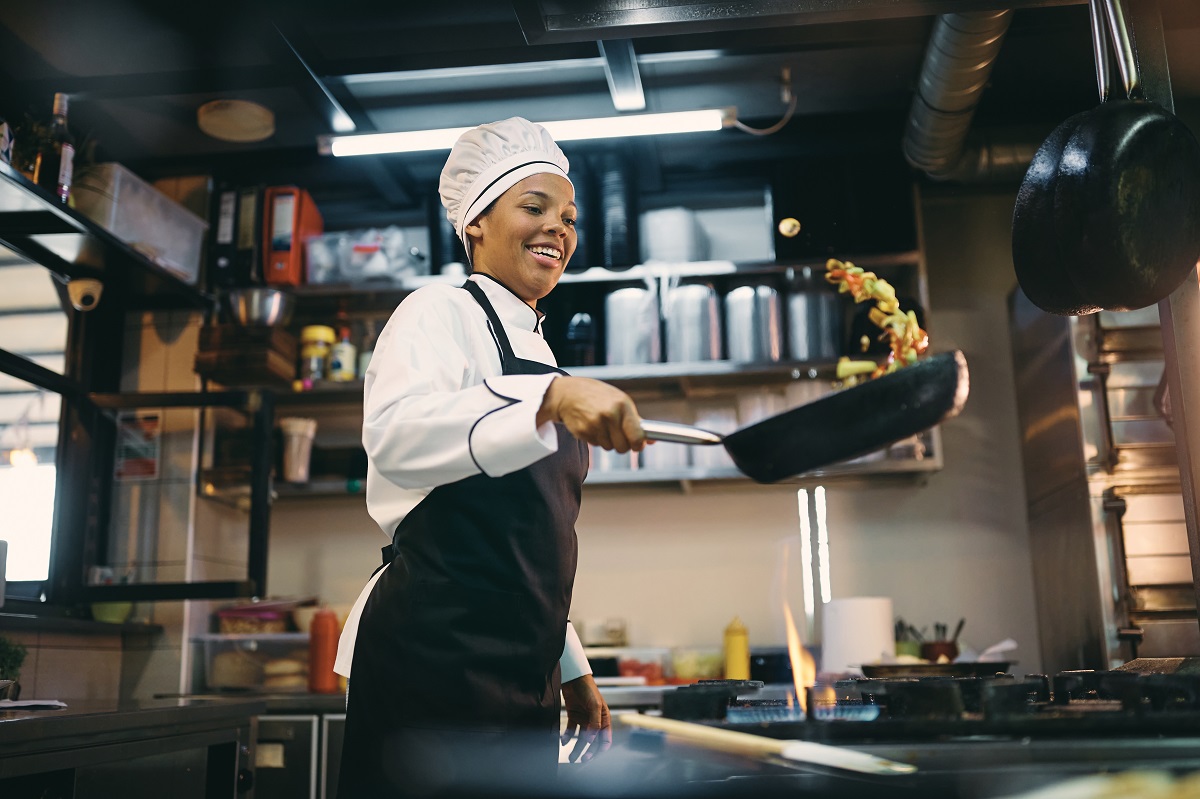It’s happened to you or someone you know: You go out to eat one day, and the next day, you’re sequestered in the bathroom absolutely sick to your stomach.
Though the U.S. has one of the safest food supply chains in the world, one in six Americans will contract a foodborne illness this year, with an estimated 48 million affected annually.1 While most cases of foodborne infection or food poisoning are mild and come and go within a day or two, some can actually be deadly.
What’s more, food poisoning isn’t just bad for customers’ health. It’s also terrible for business: after Chipotle experienced a series of food poisoning outbreaks in 20152 (and again in 2018), the company faced criminal charges for failing to follow safe food handling protocols, resulting in losses to their stock prices, their revenue, and their reputation.3
If you run or lead a restaurant, it’s up to you and your staff to keep your customers safe from food poisoning by keeping your establishment clean and enacting food safety protocols. Fortunately, we’re here to help.
In this article, we’ll discuss the most common causes of foodborne illnesses and outbreaks, the best food safety tips, and important procedures to implement to keep your restaurant clean and your patrons safe.
Introduction to Foodborne Illnesses
Preventing food poisoning starts with understanding the various ways a food item can become contaminated and make people sick.
What are Foodborne Illnesses?
Foodborne illnesses (also known as food poisoning) are infections or irritations of the gastrointestinal tract caused by food or beverages.4 While certain foods are more likely to cause food poisoning than others, foodborne illnesses can come from anywhere in the food supply, whether out in the field or directly in the kitchen.
The most common symptoms of foodborne illnesses are5:
- Nausea and vomiting
- Diarrhea
- Stomach cramps and pain
- Mild fever
- Mild dehydration
Most cases of food poisoning come and go quickly: They may set in within hours or a day of the initial ingestion and clear up on their own in another day or two. It’s also worth noting that most people don’t even need to see a doctor and can nurse themselves back to health at home.5
However, some foodborne illnesses can be quite debilitating, with some people suffering life-long complications from these diseases. In fact, approximately 3000 people die every year from some kind of foodborne illness.6 This is why it’s vital for restaurant owners, managers, and staff to take food safety precautions very seriously.
Common Causes of Foodborne Illnesses
There are four main causes of foodborne illnesses.7
- Bacterial contamination – Bacteria like Salmonella and E. coli are common culprits in foodborne illnesses and can be found in anything from contaminated produce to raw meat.
- Viral contamination – These include viruses such as Norovirus and Hepatitis A, which are usually transferred during food preparation.
- Parasitic contamination – Parasites like roundworms or tapeworms in undercooked or contaminated food can lead to illnesses.
- Toxic contamination – Some foodborne illnesses, like botulism,8 are caused by a toxin produced by bacteria. Mold or chemical toxins can also lead to food poisoning.
Unfortunately, foodborne illnesses aren’t limited to raw meat or eggs. Fresh produce is a common culprit, as well.
And, while it may not seem logical, frying oil can also be a vector for bacteria and potential foodborne illness, especially if it isn’t filtered or is stored incorrectly.
Food Safety Tips
The good news is that you can take simple steps to reduce your restaurant’s risk of causing foodborne illnesses. In fact, one of the best ways to prevent foodborne illnesses is to follow common-sense food safety rules. These practices can help eliminate many potential causes of foodborne illnesses.
Proper Food Handling
Safe food handling practices can help prevent contamination, whether from the food itself, the environment in which it is prepared, or the person preparing it.
You can break down proper food handling into two main categories9:
- Separating and storing food correctly – It’s important to keep raw food, including meats, eggs, or foods in marinades separate from foods that are ready to eat, like produce, bread, or cheeses. Raw meats and eggs are a common source of foodborne illnesses, which can leech into other foods nearby. By keeping raw meat or marinating food on separate shelves (preferably lower in the fridge),10 you lower the risk of cross-contamination.
- Maintaining a clean environment – You can also help limit cross-contamination by keeping prep areas, surfaces, and cooking utensils clean, sanitized, and separated by food groups. For example, cutting boards and utensils used to handle raw meat should be kept separate from cutting boards and utensils used for produce. Additionally, cutting boards and knives should be washed in between prep work, as part of your regular restaurant cleaning schedule.
Storing and Cooking Temperatures
Cooking and storing food at the correct temperature will kill harmful pathogens, but it’s important to note that every food item has its own minimum cooking temperature. For example, whole cuts of beef or pork should be cooked to 145 degrees Fahrenheit, while whole chicken’s internal temperature should read at least 165 before consumption.9
Storing food is just as important as cooking it. Refrigerators should run at 40 degrees or lower to ensure freshness and keep bacteria from growing. Alternatively, temperatures between 40 and 140 degrees are considered “danger zones.” Food shouldn’t be left at these temperatures for longer than an hour, as bacteria can start multiplying when food reaches room temperature (or higher).9
Personal Hygiene
Foodborne illnesses don’t just come from food. They can also come from the people preparing the food. The best way to avoid this transmission of foodborne illnesses is to emphasize the importance of personal hygiene for all staff members. In particular, you want to emphasize:
- Having a regular handwashing practice
- Wearing clean clothes, including aprons
- Staying home when sick
- Covering wounds (like cuts or burns)

Training, Education, Monitoring, and Compliance
Implementing regular food safety training is key to running a successful restaurant.
It’s imperative that your staff understand and execute food safety procedures to protect the customers, the company, and themselves.
In addition to training staff, it’s important to conduct regular safety audits to ensure that your restaurant is following regulations and updating practices based on the latest information.
Regular Staff Training
Food safety regulations are constantly evolving, so it’s essential to provide your staff with regular, ongoing training on food safety and hygiene practices.
Governing bodies like the Food and Drug Administration (FDA) set food safety rules and regulations in place. Each state and/or county may have its own food safety requirements, but the minimum steps include:
- Certifying employees – Make sure all staff members have a food handlers permit or certificate and that each employee recertifies within the required timeframe (usually six months to a year).11
- Trained at hiring – New employees should undergo extensive food safety training once they’re hired. This training should include the basics of foodborne illness, proper handling practices, and personal hygiene.12
- Regular retraining – Each restaurant staff member should go through a refresher course on food safety every six months or once a year at minimum.
Conducting Food Safety Audits
A food safety audit is a thorough review of a dining establishment’s adherence to food safety regulations.
Conducting regular audits can help ensure compliance with food safety standards. That’s because these audits touch on every aspect of food safety, including:
- Food preparation processes
- Food safety procedures
- Food safety documentation
- Facilities as a whole
- Employee food handling practices
Once your audit is complete, you can give your restaurant staff a list of areas of improvement. Essentially, food safety audits give teams a chance to make changes, retrain, or implement new regulations.
At this point, you may be wondering if food safety audits and inspections are the same thing. They actually aren’t.
Food safety inspections are usually conducted by a government regulating body, like the FDA or USDA. What’s more, they tend to be unannounced and focus on the establishment in the present moment. On the other hand, food safety audits are planned and typically take on a wider scope.3
Staying Updated with Regulations
Information about food safety is constantly changing. That’s why it’s necessary to keep up-to-date with local and national food safety regulations to ensure your restaurant meets all requirements. This includes staying on top of7:
- Food safety recalls
- The latest information about illnesses, like avian flu and others
- New food safety procedures, updated based on current research
- Helpful food safety tips in the case of disaster, like a loss of power
Protect Your Customers From Foodborne Illness with Help from Restaurant Technologies
Understanding the causes of foodborne illnesses—and how to prevent them from spreading—is one of the most important things a restaurant can do. Not only does it protect diners from exposure to bacteria, disease, and other pathogens, but it also bolsters an establishment’s overall reputation and standing.
And Restaurant Technologies is here to help.
Let us control your kitchen chaos by automating solutions for the hardest jobs in the kitchen: specifically, managing your frying oil. From procurement to proper disposal, our fleet of experts and unique restaurant oil management systems allow for a safer, cleaner, and more efficient kitchen. Speak with a representative about our cooking oil management systems today.
Sources:
- FDA. “What You Need to Know about Foodborne Illnesses.” https://www.fda.gov/food/consumers/what-you-need-know-about-foodborne-illnesses
- Vox. “How Chipotle made hundreds of people barf.” https://www.youtube.com/watch?v=0oJ6cYyr1bQ
- Food Safe Drains. “What is a Food Safety Audit.” https://blog.foodsafedrains.com/food-safety-audit
- Verywell Health. “What Causes Food Poisoning.” https://www.verywellhealth.com/what-causes-food-poisoning-7567328
- Mayo Clinic. “Food poisoning.” https://www.mayoclinic.org/diseases-conditions/food-poisoning/symptoms-causes/syc-20356230
- CDC. “Findings | Estimates of Foodborne Illnesses.” https://www.cdc.gov/foodborneburden/2011-foodborne-estimates.html
- Food Safety. “Food Poisoning.” https://www.foodsafety.gov/food-poisoning
- Mayo Clinic. “Botulism.” https://www.mayoclinic.org/diseases-conditions/botulism/symptoms-causes/syc-20370262
- CDC. “About Four Steps to Food Safety.” https://www.cdc.gov/food-safety/prevention/index.html
- State Food Safety. “Fridge Storage for Food Safety.” https://www.statefoodsafety.com/Resources/Resources/fridge-storage-for-food-safety
- LinkedIn. “How often should you refresh food safety training for restaurant staff?” https://www.linkedin.com/advice/1/how-often-should-you-refresh-food-safety-training-uvzvc
- Safety Culture. “A Quick Guide About Food Safety Training.” https://safetyculture.com/topics/food-safety/food-safety-training/






